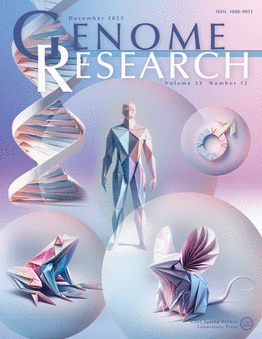Systematic identification of interchromosomal interaction networks supports the existence of specialized RNA factories
IF 6.2
2区 生物学
Q1 BIOCHEMISTRY & MOLECULAR BIOLOGY
引用次数: 0
Abstract
Most studies of genome organization have focused on intrachromosomal (cis) contacts because they harbor key features such as DNA loops and topologically associating domains. Interchromosomal (trans) contacts have received much less attention, and tools for interrogating potential biologically relevant trans structures are lacking. Here, we develop a computational framework that uses Hi-C data to identify sets of loci that jointly interact in trans. This method, trans-C, initiates probabilistic random walks with restarts from a set of seed loci to traverse an input Hi-C contact network, thereby identifying sets of trans-contacting loci. We validate trans-C in three increasingly complex models of established trans contacts: the Plasmodium falciparum var genes, the mouse olfactory receptor "Greek islands", and the human RBM20 cardiac splicing factory. We then apply trans-C to systematically test the hypothesis that genes coregulated by the same trans-acting element (i.e., a transcription or splicing factor) colocalize in three dimensions to form "RNA factories" that maximize the efficiency and accuracy of RNA biogenesis. We find that many loci with multiple binding sites of the same DNA binding proteins interact with one another in trans, especially those bound by factors with intrinsically disordered domains. Similarly, clustered binding of a subset of RNA-binding proteins correlates with trans interaction of the encoding loci. Intriguingly, we observe that these trans-interacting loci are close to nuclear speckles. Our findings support the existence of trans interacting chromatin domains (TIDs) driven by RNA biogenesis. Trans-C provides an efficient computational framework for studying these and other types of trans interactions, empowering studies of a poorly understood aspect of genome architecture.染色体间相互作用网络的系统鉴定支持专门的 RNA 工厂的存在
对基因组组织的大多数研究都集中在染色体内(顺式)接触上,因为它们蕴藏着 DNA 环状和拓扑关联结构域等关键特征。染色体间(反式)接触受到的关注要少得多,而且也缺乏对潜在的生物相关反式结构进行研究的工具。在这里,我们开发了一个计算框架,利用 Hi-C 数据来识别反式联合相互作用的基因位点集。这种方法(trans-C)从一组种子基因位点开始重新启动概率随机游走,遍历输入的 Hi-C 接触网络,从而识别出反式接触的基因位点集。我们在恶性疟原虫变异基因、小鼠嗅觉受体 "希腊岛 "和人类 RBM20 心脏剪接工厂这三个日益复杂的反式接触模型中验证了 trans-C。然后,我们应用反式-C 系统地检验了以下假设:由相同反式作用元件(即转录或剪接因子)核心调节的基因在三维空间共定位,形成 "RNA 工厂",最大限度地提高 RNA 生物发生的效率和准确性。我们发现,许多具有相同 DNA 结合蛋白的多个结合位点的基因座在反式中相互影响,尤其是那些由具有内在无序结构域的因子结合的基因座。同样,一部分 RNA 结合蛋白的集群结合也与编码基因座的反式相互作用有关。有趣的是,我们观察到这些反式相互作用的基因座靠近核斑点。我们的研究结果支持由 RNA 生物发生驱动的反式相互作用染色质域(TIDs)的存在。Trans-C 为研究这些和其他类型的反式相互作用提供了一个高效的计算框架,从而为研究基因组结构中一个鲜为人知的方面提供了可能。
本文章由计算机程序翻译,如有差异,请以英文原文为准。
求助全文
约1分钟内获得全文
求助全文
来源期刊

Genome research
生物-生化与分子生物学
CiteScore
12.40
自引率
1.40%
发文量
140
审稿时长
6 months
期刊介绍:
Launched in 1995, Genome Research is an international, continuously published, peer-reviewed journal that focuses on research that provides novel insights into the genome biology of all organisms, including advances in genomic medicine.
Among the topics considered by the journal are genome structure and function, comparative genomics, molecular evolution, genome-scale quantitative and population genetics, proteomics, epigenomics, and systems biology. The journal also features exciting gene discoveries and reports of cutting-edge computational biology and high-throughput methodologies.
New data in these areas are published as research papers, or methods and resource reports that provide novel information on technologies or tools that will be of interest to a broad readership. Complete data sets are presented electronically on the journal''s web site where appropriate. The journal also provides Reviews, Perspectives, and Insight/Outlook articles, which present commentary on the latest advances published both here and elsewhere, placing such progress in its broader biological context.
 求助内容:
求助内容: 应助结果提醒方式:
应助结果提醒方式:


